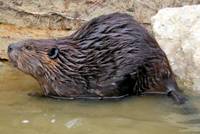|
"Your gateway to
understanding |
American Beaver

- The official mammal of New York State
- Alters its habitat more than any other animal except humans
- Lodges and dams are often spotted when driving through Cicero Swamp
The beaver is the largest rodent found in North America, and is native to Oneida Lake. Beavers have rounded heads and distinctive orange incisor teeth that are used to cut down trees. They possess a large, flat, paddle-shaped tail, which is used to signal danger and is also used for fat storage. Beavers have small un-webbed front paws with claws, and have webbed hind feet for swimming. A beaver’s nostrils and ears can close when submerged, and the eyes are covered by a membrane that allows them to see underwater. To stay warm in their cold water environment, beavers have dark brown fur that covers a thick layer of fat.
Beavers are mainly active at night when they are building or searching for food. Because beavers are more vulnerable on land, they tend to stay in the water as much as possible and are able to remain submerged for up to 15 minutes. During the summer, beavers eat grasses, cattails, water lilies and other aquatic plants. They may make their homes in river banks, but are best known for building dams across streams and constructing "lodges" in the artificial ponds that form. Besides providing a safe home, these beaver ponds provide habitat for waterfowl and other aquatic animals. Beaver dams are typically constructed out of birch, aspen, willow and poplar trees, and researchers have shown that the sound of running water dictates where a beaver will build.
The beaver exerts more influence on its habitat than any other creature except man, and in some places this has become a nuisance. Dams may flood private property and roads, and beavers are often attracted to the ornamental trees and shrubs that people plant. When this occurs on the small streams that lead into Oneida Lake, DEC wildlife personnel are called in to provide management assistance. Because beavers are persistent in repairing damage to a dam, the only way to stop them from building is to remove them from the area. Captured beavers are released in wooded areas away from humans, or in marshy areas such as Cicero Swamp where prime habitat exists without the need for a dam.
The current North American beaver population is estimated to be 10 to 15 million individuals, though there may have been ten times that many before the fur trade of the 19th century. Today, because of small coyote and red fox populations in the area, beavers have few natural predators and often get out of control. Without natural predators, trapping by hunters and vehicle fatalities are the primary beaver population controls around Oneida Lake.
To learn more about the American Beaver ...
